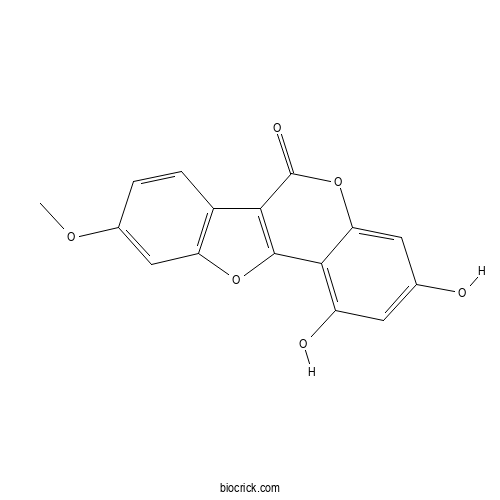Hedysarimcoumestan BCAS# 899436-04-5 |

Quality Control & MSDS
3D structure
Package In Stock
Number of papers citing our products

| Cas No. | 899436-04-5 | SDF | Download SDF |
| PubChem ID | 11558452.0 | Appearance | Powder |
| Formula | C16H10O6 | M.Wt | 298.25 |
| Type of Compound | Phenols | Storage | Desiccate at -20°C |
| Solubility | Soluble in Chloroform,Dichloromethane,Ethyl Acetate,DMSO,Acetone,etc. | ||
| Chemical Name | 1,3-dihydroxy-9-methoxy-[1]benzofuro[3,2-c]chromen-6-one | ||
| SMILES | COC1=CC2=C(C=C1)C3=C(O2)C4=C(C=C(C=C4OC3=O)O)O | ||
| Standard InChIKey | AAKHRTZXSZBLFQ-UHFFFAOYSA-N | ||
| Standard InChI | InChI=1S/C16H10O6/c1-20-8-2-3-9-11(6-8)21-15-13(9)16(19)22-12-5-7(17)4-10(18)14(12)15/h2-6,17-18H,1H3 | ||
| General tips | For obtaining a higher solubility , please warm the tube at 37 ℃ and shake it in the ultrasonic bath for a while.Stock solution can be stored below -20℃ for several months. We recommend that you prepare and use the solution on the same day. However, if the test schedule requires, the stock solutions can be prepared in advance, and the stock solution must be sealed and stored below -20℃. In general, the stock solution can be kept for several months. Before use, we recommend that you leave the vial at room temperature for at least an hour before opening it. |
||
| About Packaging | 1. The packaging of the product may be reversed during transportation, cause the high purity compounds to adhere to the neck or cap of the vial.Take the vail out of its packaging and shake gently until the compounds fall to the bottom of the vial. 2. For liquid products, please centrifuge at 500xg to gather the liquid to the bottom of the vial. 3. Try to avoid loss or contamination during the experiment. |
||
| Shipping Condition | Packaging according to customer requirements(5mg, 10mg, 20mg and more). Ship via FedEx, DHL, UPS, EMS or other couriers with RT, or blue ice upon request. | ||

Hedysarimcoumestan B Dilution Calculator

Hedysarimcoumestan B Molarity Calculator
| 1 mg | 5 mg | 10 mg | 20 mg | 25 mg | |
| 1 mM | 3.3529 mL | 16.7645 mL | 33.5289 mL | 67.0578 mL | 83.8223 mL |
| 5 mM | 0.6706 mL | 3.3529 mL | 6.7058 mL | 13.4116 mL | 16.7645 mL |
| 10 mM | 0.3353 mL | 1.6764 mL | 3.3529 mL | 6.7058 mL | 8.3822 mL |
| 50 mM | 0.0671 mL | 0.3353 mL | 0.6706 mL | 1.3412 mL | 1.6764 mL |
| 100 mM | 0.0335 mL | 0.1676 mL | 0.3353 mL | 0.6706 mL | 0.8382 mL |
| * Note: If you are in the process of experiment, it's necessary to make the dilution ratios of the samples. The dilution data above is only for reference. Normally, it's can get a better solubility within lower of Concentrations. | |||||

Calcutta University

University of Minnesota

University of Maryland School of Medicine

University of Illinois at Chicago

The Ohio State University

University of Zurich

Harvard University

Colorado State University

Auburn University

Yale University

Worcester Polytechnic Institute

Washington State University

Stanford University

University of Leipzig

Universidade da Beira Interior

The Institute of Cancer Research

Heidelberg University

University of Amsterdam

University of Auckland

TsingHua University

The University of Michigan

Miami University

DRURY University

Jilin University

Fudan University

Wuhan University

Sun Yat-sen University

Universite de Paris

Deemed University

Auckland University

The University of Tokyo

Korea University
- 2-(3,4-dihydroxyphenyl)-7-(β-D-glucopyranosyloxy)-8-hydroxy-4H-1-benzopyran-4-one
Catalog No.:BCX1234
CAS No.:925701-05-9
- Sikokianin E
Catalog No.:BCX1233
CAS No.:2253791-96-5
- Isocoreopsin
Catalog No.:BCX1232
CAS No.:30382-18-4
- Dihydrobaicalin
Catalog No.:BCX1231
CAS No.:56226-98-3
- Segetalin C
Catalog No.:BCX1230
CAS No.:177602-12-9
- 2,7-dihydroxy-4, 6-dimethoxy phenanthrene
Catalog No.:BCX1229
CAS No.:108352-70-1
- Argentinogenin
Catalog No.:BCX1228
CAS No.:4236-48-0
- β-Obscurin
Catalog No.:BCX1227
CAS No.:467-79-8
- Cnidimol B
Catalog No.:BCX1226
CAS No.:103629-81-8
- Erythro-guaiacylglycerol-β-O-4'-sinapyl ether
Catalog No.:BCX1225
CAS No.:905726-70-7
- threo-guaiacylglycerol-β-O-4'-sinapyl ether
Catalog No.:BCX1224
CAS No.:288864-26-6
- 5,7-Dihydroxychroman-4-one
Catalog No.:BCX1223
CAS No.:108085-46-7
- t-OMe-Byakangelicin
Catalog No.:BCX1236
CAS No.:89560-97-4
- Albanol B
Catalog No.:BCX1237
CAS No.:87084-99-9
- Ekersenin
Catalog No.:BCX1238
CAS No.:53091-74-0
- Oxypeucedanin methanolate
Catalog No.:BCX1239
CAS No.:52939-12-5
- 1-O-gentiobiosyl-3,7-dimethoxy-8-hydroxyxanthone
Catalog No.:BCX1240
CAS No.:487040-33-5
- Chikusaikoside II
Catalog No.:BCX1241
CAS No.:166338-14-3
- Damnacanthol
Catalog No.:BCX1242
CAS No.:477-83-8
- Aconicarchamine B
Catalog No.:BCX1243
CAS No.:1275535-67-5
- Hypolaetin 7-O-glucoside
Catalog No.:BCX1244
CAS No.:32455-43-9
- Hypoletin-7-O-β-D-xylopyranoside
Catalog No.:BCX1245
CAS No.:126771-28-6
- Carmichasine B
Catalog No.:BCX1246
CAS No.:2245700-60-9
- trans-Ferulic acid-4-β-glucoside
Catalog No.:BCX1247
CAS No.:117405-51-3
Potential Leads from Liquorice Against SARS-CoV-2 Main Protease using Molecular Docking Simulation Studies.[Pubmed:32807047]
Comb Chem High Throughput Screen. 2021;24(4):591-597.
AIM AND OBJECTIVE: At present, the world is facing a global pandemic threat of SARSCoV- 2 or COVID-19 and to date, there are no clinically approved vaccines or antiviral drugs available for the treatment of coronavirus infections. Studies conducted in China recommended the use of liquorice (Glycyrrhiza species), an integral medicinal herb of traditional Chinese medicine, in the deactivation of COVID-19. Therefore, the present investigation was undertaken to identify the leads from the liquorice plant against COVID-19 using molecular docking simulation studies. MATERIALS AND METHODS: A set of reported bioactive compounds of liquorice were investigated for COVID-19 main protease (M(pro)) inhibitory potential. The study was conducted on Autodock vina software using COVID-19 M(pro) as a target protein having PDB ID: 6LU7. RESULTS: Out of the total 20 docked compounds, only six compounds showed the best affinity towards the protein target, which included glycyrrhizic acid, isoliquiritin apioside, glyasperin A, liquiritin, 1-methoxyphaseollidin and Hedysarimcoumestan B. From the overall observation, glycyrrhizic acid followed by isoliquiritin apioside demonstrated the best affinity towards M(pro) representing the binding energy of -8.6 and -7.9 Kcal/mol, respectively. Nevertheless, the other four compounds were also quite comparable with the later one. CONCLUSION: From the present investigation, we conclude that the compounds having oxane ring and chromenone ring substituted with hydroxyl 3-methylbut-2-enyl group could be the best alternative for the development of new leads from liquorice plant against COVID-19.


